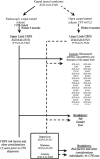National Trends in the Diagnosis of CRPS after Open and Endoscopic Carpal Tunnel Release
- PMID: 31192042
- PMCID: PMC6546494
- DOI: 10.1055/s-0039-1678674
National Trends in the Diagnosis of CRPS after Open and Endoscopic Carpal Tunnel Release
Abstract
Background Complex regional pain syndrome (CRPS) occurs in 2 to 8% of patients that receive open or endoscopic carpal tunnel release (CTR). Because CRPS is difficult to treat after onset, identifying risk factors can inform prevention. We determined the incidence of CRPS following open and endoscopic CTR using a national claims database. We also examined whether psychosocial conditions were associated with CRPS after CTR. Methods We accessed insurance claims using diagnostic and procedural codes. We calculated the incidence of CRPS following open carpal tunnel release and endoscopic carpal tunnel release within 1 year. The response variable was the presence of CRPS after CTR. Explanatory variables included procedure type, age, gender, and preoperative diagnosis of anxiety or depression. Results The number of open CTRs (85% of total) outweighs the number of endoscopic procedures. In younger patients, the percentage of endoscopic CTRs is increasing. Rates of CRPS are nearly identical between surgery types for both privately insured (0.3%) and Medicare patients (0.1%). Middle aged (range: 40-64 years) and female patients had significantly higher rates of CRPS than did the general population. Preoperative psychosocial conditions did not correlate with the presence of CRPS in surgical patients. Clinical Relevance The decision between endoscopic and open CTR should not be made out of concern for development of CRPS postsurgery, as rates are low and similar for both procedures. Rates of CRPS found in this study are much lower than rates found in previous studies, indicating inconsistency in diagnosis and reporting or generalizability of prior work. Preoperative psychosocial disorders and CRPS are unrelated.
Keywords: carpal tunnel release; carpal tunnel syndrome; complex regional pain syndrome; quality.
Conflict of interest statement
Figures





Similar articles
-
Trends and Complications in Open Versus Endoscopic Carpal Tunnel Release in Private Payer and Medicare Patient Populations.Hand (N Y). 2019 Jul;14(4):455-461. doi: 10.1177/1558944717751196. Epub 2018 Jan 11. Hand (N Y). 2019. PMID: 29322873 Free PMC article.
-
Trends in Open vs. Endoscopic Carpal Tunnel Release: A Comprehensive Survey in Japan.J Clin Med. 2022 Aug 24;11(17):4966. doi: 10.3390/jcm11174966. J Clin Med. 2022. PMID: 36078895 Free PMC article.
-
Perioperative Narcotic Use and Carpal Tunnel Release: Trends, Risk Factors, and Complications.Hand (N Y). 2020 Mar;15(2):234-242. doi: 10.1177/1558944718792276. Epub 2018 Aug 1. Hand (N Y). 2020. PMID: 30067126 Free PMC article.
-
The Incidence of Complex Regional Pain Syndrome in Simultaneous Surgical Treatment of Carpal Tunnel Syndrome and Dupuytren Contracture.Hand (N Y). 2018 Jul;13(4):391-394. doi: 10.1177/1558944717718345. Epub 2017 Jul 8. Hand (N Y). 2018. PMID: 28691512 Free PMC article. Review.
-
Results of open carpal tunnel release: a comprehensive, retrospective study of 188 hands.Aust N Z J Surg. 1997 May;67(5):283-8. doi: 10.1111/j.1445-2197.1997.tb01964.x. Aust N Z J Surg. 1997. PMID: 9152160 Review.
Cited by
-
Endoscopic Versus Open Carpal Tunnel Release.Curr Rev Musculoskelet Med. 2019 Dec;12(4):509-514. doi: 10.1007/s12178-019-09584-0. Curr Rev Musculoskelet Med. 2019. PMID: 31773481 Free PMC article. Review.
-
The Association of Insurance Status and Complications After Carpal Tunnel Release.Hand (N Y). 2023 Mar;18(2):192-197. doi: 10.1177/1558944721990818. Epub 2021 Feb 25. Hand (N Y). 2023. PMID: 33631982 Free PMC article.
-
Management of failed carpal tunnel decompression.EFORT Open Rev. 2025 Jun 2;10(6):352-360. doi: 10.1530/EOR-2025-0058. EFORT Open Rev. 2025. PMID: 40459165 Free PMC article.
References
-
- Birklein F, O'Neill D, Schlereth T. Complex regional pain syndrome: an optimistic perspective. Neurology. 2015;84(01):89–96. - PubMed
-
- Jänig W, Baron R. Complex regional pain syndrome is a disease of the central nervous system. Clin Auton Res. 2002;12(03):150–164. - PubMed
-
- Maihöfner C. [Complex regional pain syndrome: a current review] Schmerz. 2014;28(03):319–336. - PubMed
-
- Bruehl S. Complex regional pain syndrome. BMJ. 2015;351:h2730. - PubMed
-
- Li Z, Smith B P, Smith T L, Koman L A. Diagnosis and management of complex regional pain syndrome complicating upper extremity recovery. J Hand Ther. 2005;18(02):270–276. - PubMed
LinkOut - more resources
Full Text Sources

